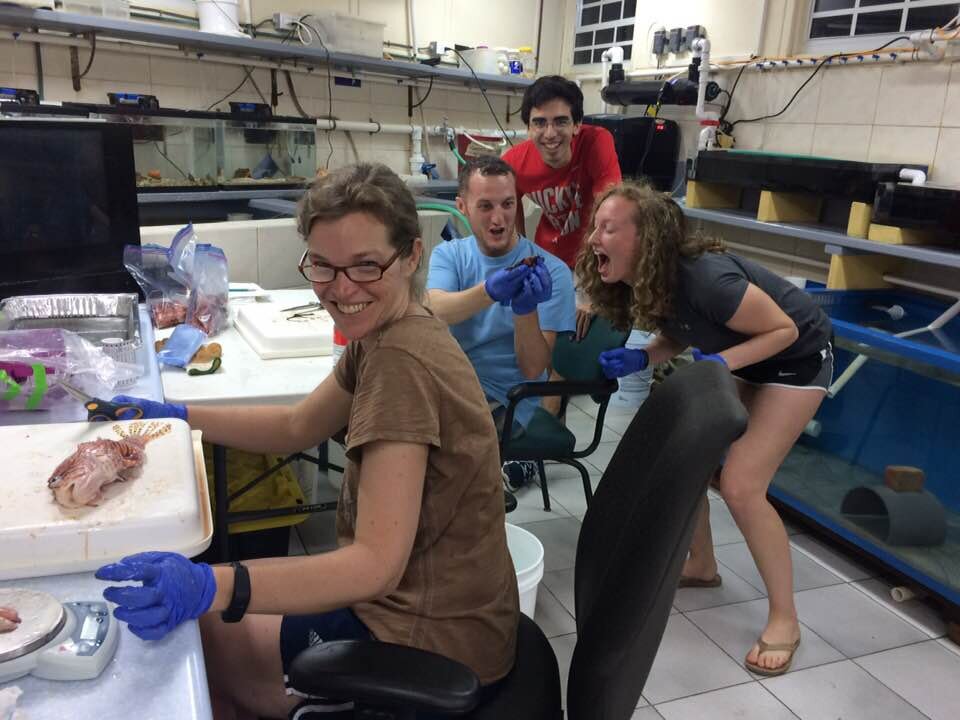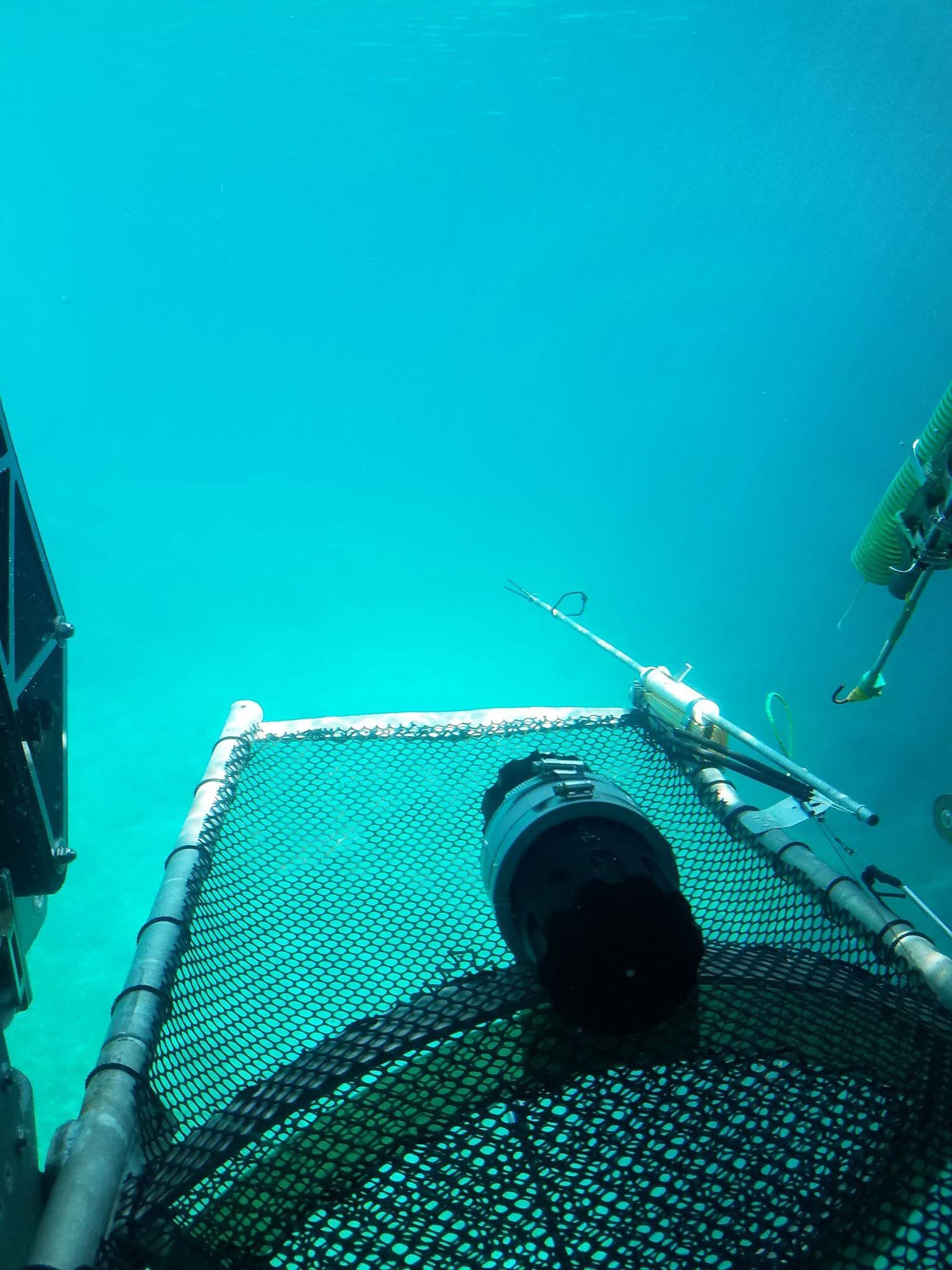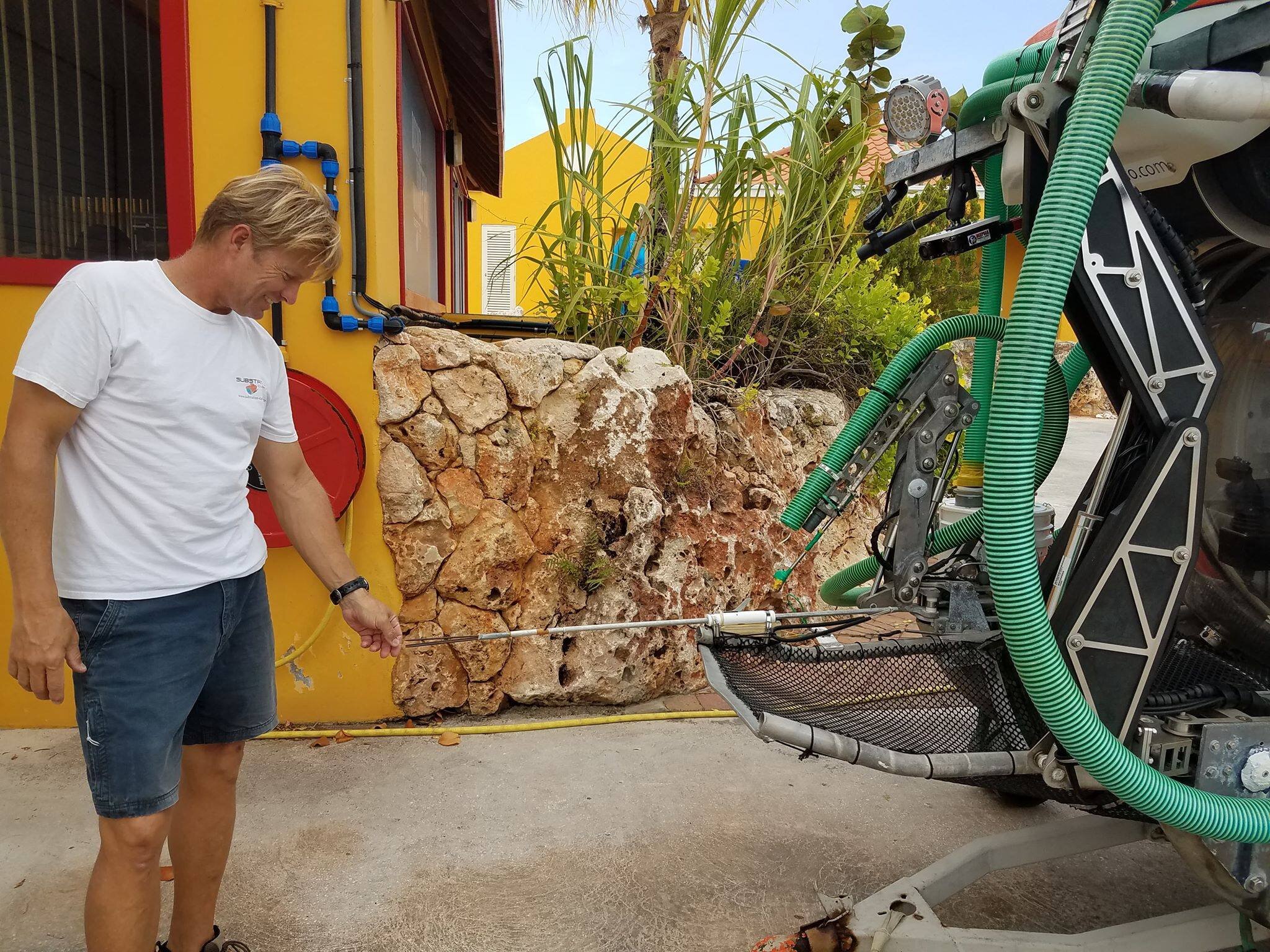Author: Sarah Panciroli
Invasive species pose a huge threat to marine biodiversity. One of the most notorious and alarming cases of this is the invasive lionfish that has rapidly invaded the tropical and subtropical western Atlantic coastal ecosystem since the late 1980’s. Voracious, predatory, and successful, this species owes its success to its morphological and behavioral traits. Lionfish have an unusual shape with venomous spines concealed in their feathery appendages protruding from their body. Along with this confusing shape, lionfish are outfitted in a maze of vibrant stripes and cryptic coloration. These defensive characters are accompanied by a wide range of feeding behaviors, a generalist diet, and protection from many parasites. This fish is rapidly decimating populations and becoming the locust of the sea.
Lionfish are typically found in coastal waters, where control over their invasion is in reach of scientists and management efforts such as incentivized lionfish derbies. This issue of massive invasion could be somewhat manageable if lionfish were exclusive to this shallow region, but in recent years they have been found in reefs deeper than 300 meters in the Caribbean region (Gress et al. 2017)— which means the devastating impact this creature has on ocean diversity may get a whole lot deeper.
Lionfish that occupy deep-reef ecosystems presents even greater concerns because shallow-reef environments possess resilient qualities, containing diverse populations and a large prey availability, mitigating effects of invasive predators. In contrast, deep-reef ecosystems have less habitat availability, limited species diversity and prey availability. Ecosystems like this can be easily exploited by an invasive species that can wipe out large volumes of biomass (Andradi-Brown et al 2017). Controlling lionfish populations is also an overwhelming feat, as derbies and other methods would be near impossible at depths 50-300m.




Deep reef ecosystems have historically lacked the wealth of information that are available for shallow reefs, which has led to new scientific programs specifically looking to investigate biodiversity and conservation on deep reefs. The Smithsonian’s DROP (Deep Reef Observation Project) is one of these programs which has contributed to research on relationships between deep and shallow environments, focusing on biodiversity, conservation, and evolution. In 2017, UW partnered with DROP. Through this collaboration, the University of Washington pioneered a lionfish research project to learn more about the impacts of lionfish that occupied deep reef ecosystems. DROP uses submersibles that have the capability to collect lionfish occupying deep reefs, allowing us to ask whether lionfish on deep reefs occupy different trophic positions than lionfish on shallow reefs. The project was jump started when University of Washington graduate Megan Ewing was introduced to this question while working in the Burke Museum Fish Collection.
Trophic positions of deep-reef lionfish was a question that sparked the interest of undergraduate Megan Ewing in the Spring of 2020. While working in the fish collection, she was introduced to the numerous lionfish preserved in the labs deep freezer, collected by DROP using a submersible called the CURASUB in Curaçao. After several months of identifying and cataloging typically tiny specimens, Megan was excited to work with the larger creatures and answer questions related to the invasive lionfish. The basis of this question of diet and trophic positions relied on a concept called stable isotope analysis, using the two isotopes δ13C and δ15N. These elements would ultimately tell us two things: carbon isotope ratios would explain what environment the lionfish were eating, as carbon signatures found in a species can be matched to unique signatures found in specific marine habitats (deep reefs vs shallow reefs). Nitrogen isotope ratios show what trophic level an animal is eating, because nitrogen accumulates up the food chain. This background knowledge helped guide Megan’s hypotheses that deep populations of lionfish will have enriched δ15N values compared to shallow populations. This is because the increased energetic demands of more mature and larger fish found on deep reefs will lead to more prey consumption and a higher trophic position. Deep populations of lionfish will also have slightly depleted δ13C values compared to shallow populations as δ13C typically becomes depleted with depth (Fry et al. 1982, Fry et al. 1988).
The lionfish project began with 76 fish captured off reefs in Curaçao, Caribbean, 31 collected in shallow reefs, and 45 from deep reefs. Megan extracted heart, muscle, and scale tissues to examine dietary changes over short, intermediate, and long time scales respectively. Once tissue samples were organized and extracted, they needed to be prepared for bulk stable carbon and nitrogen isotope sample, a process described through (Peterson & Fry 1987), which involved grinding and weighing each 3 tissue samples of all 76 lionfish. This may sound simple, but grinding each sample of lionfish alone took three months, with time consuming obstacles like extensive sterilization, assuring the samples were consistently a baking powder consistency, and funneling these samples into tiny vials. The next step of preparation involved weighing the small bits of powder produced from grinding. “Weighing” cannot simply capture the amount of effort exerted into this process. Each sample had to weigh between .4-.425 mg, a difference that is not detectable to the human eye and comparable to the weight of an eyebrow hair. A sample this small was transported using scoops the size of a grain of rice. Once the sample was finally in the correct weight range, it was folded in its vessel in a very particular shape and placed into a capsule on a 96 well plate, among many other samples. To call this process precise would be an understatement, and is a testimony to the amount of focus and determination that science sometimes requires. Adding to the intensity of this work, a large portion of it was done in Megan’s home during a global pandemic. When everything was finally in its perfect place and measured state, the samples were sent to the UC Davis stable isotope facility to determine the δ13C and δ15N ratios.
Proceeding the lengthy scientific methods, the highly anticipated results were eventually received from the UC Davis isotope sampling lab in 2021. For all tissues, there was no significant difference in δ 13C between shallow and deep populations, but the δ 13C range of deep populations is broader than and overlapping with shallow populations. However, deep population lionfish had enriched δ 15N when compared to the shallow reef lionfish. In addition to confirming Megan’s original hypothesis, this information presented several conclusions. The increased and overlapping range of δ13C for deep populations when compared to shallow populations indicates that not only do they likely have larger habitat range when compared to shallow populations, but there could also be a vertical migration by the deep reef populations to shallow environments (Fry et al. 1982). The increased δ 15N in deep reef lionfish also indicates that they occupy a higher trophic position, as nitrogen accumulates up the food chain.
The implications of these results provide areas of concern, but also room for hope. If deep reef lionfish are indeed undergoing vertical migration, controls on these populations would be more feasible with greater management pressure exerted when these populations are feeding in shallow reefs. However, the higher trophic position of deep reef populations has major consequences for their surrounding habitats. Lionfish are invasive generalist predators, so as their trophic position increases, abundance and diversity of native prey will drastically decrease. Increased studies on deep reef populations to truly understand the implications of higher trophic level lionfish feeding will most likely proceed this work and strengthen this study. Research could be done to determine when these populations are migrating to shallow environments, to make management efforts more impactful to eradicate this population. Ultimately, there a distinction to be made between these two populations of lionfish- providing greater motivation in exterminating this invasive species when it threatens a less researched habitat in the ocean that is clearly more vulnerable to the effects of a high trophic feeding animal.
Behind the researcher:
The extensive research and scientific experimentation required to answer this question would not be possible without University of Washington’s graduate Megan Ewing. Many factors contributed to Megan gaining interest on marine related projects such as these. For Megan, the college experience was novel in her family, being the first of her immediate family to go to a university. This situation added several challenges, such as a lack of guidance and support when applying to college, and figuring out the intricacies and confusion that are associated with applications. Nevertheless, Megan was successfully accepted to the University of Washington, a highly acclaimed and competitive college. The first years of college are met with curiosity and typically an uncertainty in academic direction. Megan wasn’t originally drawn to marine and fishery studies, and instead was dead-set on business, specifically marketing for nonprofits and sustainable ocean companies, but when the major didn’t work out she needed a plan B. Keeping the passion for the ocean and sustainability in mind, Megan then went to the marine biology advisor who recommended taking Fish 311, a course taught by Luke Tornabene that encompassed fish biology and evolution. The first lab included a tour of the UW fish collection, a vast room containing millions of preserved specimen and endless opportunities for research: Megan was sold. Marine Biology satisfied the passion of conservation and knowledge of the ocean, but also contained hard core sciences that wasn’t originally anticipated, adding to the appeal. These qualities made marine biology turn from a childhood dream as it is often regarded, to a serious career which Megan was determined to pursue. Once settled in the major, Megan reached out to Luke to volunteer in the fish collection, where she worked on fish identification, collection organization and was interested in ecology, reproduction, and behavior predation. After countless hours working with tiny specimens, Megan was introduced to the onslaught of lionfish collected from Curaçao. Given her interest in ecology and feeding behaviors, Megan took on the lionfish project, eager to investigate important topics of invasive species and work with larger specimen. Megan continues to write up the research paper on her investigation and is currently employed as an education volunteer coordinator at the Friends of Issaquah Salmon Hatchery (FISH). Megan explains this is a “non-profit with the mission of protecting our salmon and ensuring their survival for future generations through education, advocacy, and outreach." As an education/volunteer coordinator, she works with local schools to teach children (K-12) about salmon life cycles, salmon habitats, ecology, watersheds, and the role of hatcheries.
As for the future, Megan plans to go back to school for her PhD, ideally to study reproduction in fish, and continue to find research projects that involve field work and laboratory methods. Her end goal is to become an educator, such as becoming a professor at a research heavy university just like her undergraduate alma mater.
The work provided by Megan was highly valuable and a fantastic undergraduate achievement that provided evidence that can help answer questions about this hot topic in conservation. We are positive she will continue to explore the ocean and share her knowledge with others, positively contributing to the scientific community.
